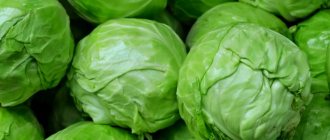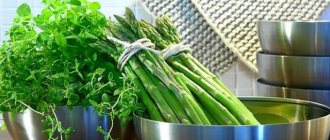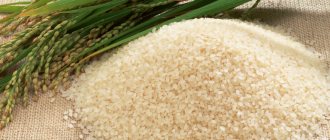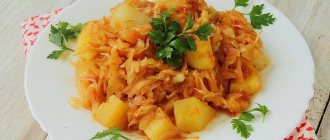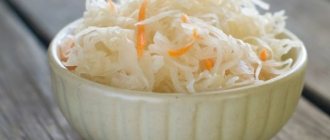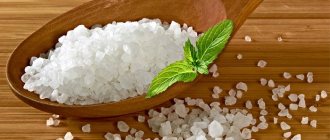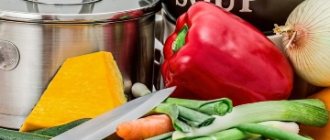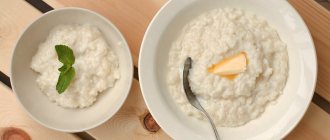Composition of broccoli and its beneficial properties
After birth, the baby needs healthy nutrition, love and development. And it is breastfeeding that can provide the basic needs of a growing child’s body, especially in the first months of a baby’s life. In order for a nursing woman to be able to give her child the necessary substances, her menu must be complete and varied. Thanks to its composition, asparagus cabbage has many beneficial properties and is considered one of the most valuable vegetables in the daily human diet. Vitamins, macro- and microelements present in broccoli enrich breast milk and have a beneficial effect on the mother’s body.
Nutritionists rank broccoli among the healthiest foods.
Table: nutritional value calculated per 100 g of product
| COMPOSITION AND CALORIE CONTENT | SUBSTANCE CONTENTS PER 100 G | % OF DAILY VALUE FOR NURSING MOTHER |
| Squirrels | 2.8 g | 3% |
| Fats | 0.4 g | 0.5% |
| Carbohydrates | 6.6 g | 2% |
| Alimentary fiber | 2.6 g | 13% |
| Water | 89.3 g | 3% |
| Calories | 34 kcal | 1.5% |
Table: essential vitamins and minerals and their benefits for baby and mother
| NUTRIENTS | SUBSTANCE CONTENTS PER 100 G | % OF DAILY VALUE FOR NURSING MOTHER | BENEFITS FOR MOTHER AND CHILD |
| Vitamin A, retinol | 386 mcg | 30% |
|
| Vitamin B1, thiamine | 0.07 mg | 4% |
|
| Vitamin B2, riboflavin | 0.12 mg | 6% |
|
| Vitamin B5, pantothenic acid | 0.57 mg | 8% |
|
| Vitamin B6, pyridoxine | 0.18 mg | 7% |
|
| Vitamin B9, folic acid | 63 mcg | 13% |
|
| Vitamin C, ascorbic acid | 89.2 mg | 74% |
|
| Vitamin E, alpha tocopherol | 0.78 mg | 4% |
|
| Vitamin K, phylloquinone | 101.6 mcg | 85% |
|
| Vitamin PP, nicotinic acid | 1.107 mg | 5% |
|
| Potassium, K | 316 mg | 13% |
|
| Calcium, Ca | 47 mg | 3.5% |
|
| Magnesium, Mg | 21 mg | 5% |
|
| Phosphorus, Ph | 66 mg | 7% |
|
| Iron, Fe | 0.73 mg | 4% |
|
| Manganese, Mn | 0.21 mg | 8% |
|
| Copper, Cu | 49 mcg | 4% |
|
| Selenium, Se | 2.5 mcg | 4% |
|
Is it possible to eat different types of cabbage vegetables during lactation?
It is worth noting that there are many types of cabbage. Some are widely distributed, others do not often reach the table of the average consumer. The most common types of cabbage:
- White cabbage.
- Red cabbage.
- Colored.
- Broccoli.
- Kohlrabi.
- Brussels.
- Beijing.
- Chinese, etc.
Let's take a closer look at which varieties of cabbage are useful and which are not recommended during breastfeeding.
Good for a nursing mother
Colored
During lactation it is considered very useful for both mother and child. It contains more vitamin C than any citrus fruit. In moderation, cauliflower rarely causes allergic reactions or gastrointestinal upset, so doctors recommend its consumption during breastfeeding.
Useful properties of the vegetable for mother and baby:
- Normalizes metabolism.
- Improves blood formation.
- Cleanses blood vessels.
- Strengthens the immune system.
- Has a beneficial effect on the nervous system, etc.
You can introduce cauliflower into your diet 2-3 weeks after birth.
Broccoli
Like cauliflower, it is one of the safest varieties during breastfeeding. This is a hypoallergenic product that is easily digested in the body of a newborn, and contains such useful elements as folic acid, vitamins A and B, and a huge amount of ascorbic acid (you can study the chemical composition of various types of cabbage in more detail here).
Beneficial properties of broccoli:
- Improves the quality of blood composition.
- Helps eliminate toxins and waste.
- Improves mood, calms.
- Strengthens the walls of blood vessels.
- It prevents cancer, etc.
Eating broccoli is recommended no earlier than a month after giving birth.
Beijing
Contains vitamins A, B, C, PP, mineral salts. It is recommended by experts for nursing mothers because of its beneficial qualities. Chinese cabbage promotes overall strengthening of the body during lactation, which has a beneficial effect on the baby.
In addition, due to its low calorie content, it is an excellent ally for weight loss after childbirth. It should be introduced into the diet gradually, in heat-treated form.
Not recommended
White cabbage
It is considered too heavy a product for a weak child’s body, especially in the first 3 months after birth. Experts do not agree, but there are versions that white cabbage causes problems with the gastrointestinal tract, colic in the tummy, excessive gas formation, etc. in infants.
Cabbage itself is very healthy, but during lactation you need to eat it very carefully, and it is better to postpone its introduction into the diet for 4-6 months after birth.
Marine
It cannot be said that it is prohibited for nursing mothers, but it is worth noting that this type of cabbage often causes allergies in the baby, and therefore it is eaten no earlier than after 3 months of lactation.
You can eat any type of cabbage in moderation, but it is important to monitor the child’s body’s reaction to a particular product.
Is it possible to eat broccoli while breastfeeding?
Broccoli is one of the foods that many pediatricians and lactation consultants advise breastfeeding mothers to include in their diet. The recommended serving size is up to 200 g per meal, so by consuming this vegetable, a woman can get a lot of useful substances. For example, 200 g of asparagus cabbage contains the required daily requirement:
- 170% vitamin K;
- 150% ascorbic acid;
- 60% vitamin A;
- more than 25% folic acid and potassium;
- other vitamins and minerals are also present in significant quantities.

The vegetable contains quite a lot of coarse dietary fiber. They are necessary for the normal functioning of the digestive system, and their intake into the body has a beneficial effect on the growth of beneficial microflora in the intestines. Fiber helps remove toxic substances and some cholesterol. And of course, it is needed to prevent constipation.
Broccoli contains beta-carotene. 6 mcg of this substance is equivalent to 1 mcg of vitamin A. Beta-carotene has antioxidant properties, has a positive effect on the functions of the visual organ, promotes active cell regeneration, maintains healthy and youthful skin, and helps the functioning of the immune system.
Sulforaphane (an organic compound of plant origin) present in asparagus cabbage is considered a very valuable substance. Medicines are made on its basis. Sulforaphane has an anticancer and antibacterial effect, prevents the occurrence of inflammatory reactions, and helps prevent many diseases.
Broccoli is a supplier of phytosterol. It reduces the amount of cholesterol in the body, preventing it from being absorbed in the intestines. Phytosterol also prevents the occurrence of malignant tumors.
What is the danger of the product?
During the period of natural feeding, it is necessary to take into account possible harm to the health of the mother and baby. Abuse of broccoli is dangerous for varicose veins, migraines, blood viscosity, and chronic gastrointestinal diseases. It is allowed with caution in case of increased acidity of gastric juice. A raw vegetable can cause flatulence and indigestion, so during lactation it is used only after heat treatment. It is necessary to take into account possible contraindications for the baby. Broccoli is a safe product, but in rare cases, individual intolerance or an allergic reaction is possible, which manifests itself in the child as increased gas formation and bloating.
On a note! Broccoli broth is dangerous when breastfeeding, because when boiled, harmful substances that can harm the baby pass into the liquid.
Potential harm of asparagus cabbage for baby and mother
Broccoli rarely provokes allergic reactions. But sometimes, when eating cabbage, a nursing mother notices that her baby has upset stools and increased gas production. This is often due to the immaturity of the baby’s digestive system and the lack of necessary enzymes. As the child grows, these symptoms disappear. Individual intolerance to asparagus cabbage may occur due to a genetically determined reaction to its protein. The baby also has congenital hypersensitivity to vitamin C. An allergy to broccoli is manifested by restlessness, itching and redness of the skin, rashes and diaper rash. Swelling of the mucous membranes of the nose and lips is possible, the eyelids become swollen, loose stools and intestinal colic are observed.
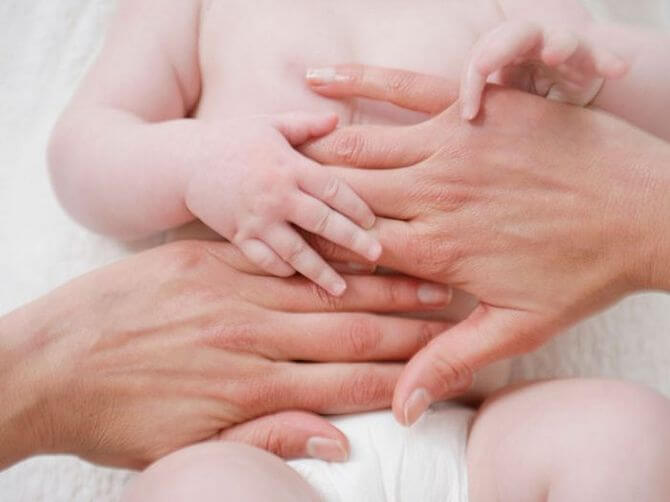
Broccoli intolerance may be due to immaturity of the child's digestive tract
Some unscrupulous producers treat vegetables with large amounts of fertilizers, trying to extend the shelf life of cabbage and rid it of pests. But an excess of these substances can provoke allergic reactions in the baby or even poisoning. In this case, nausea, vomiting, abdominal pain occur, the stool becomes liquid, and sometimes the temperature rises. Nitrates may be the cause of poisoning. Entering the mother's body with food, they penetrate into breast milk in small quantities and have a negative effect on the baby.
If your child develops any symptoms of broccoli intolerance, you should stop using this product and immediately contact your pediatrician.
Possible harm from eating broccoli by a mother while breastfeeding
Like any other incredibly healthy food, broccoli still has several side effects, which largely depend on the individual characteristics of the mother or baby.
- In rare cases, broccoli can cause allergies. Most often this happens if the vegetable was introduced incorrectly or too early. The baby’s body is simply not yet ready for a new product, and therefore reacts to it inadequately. The main symptoms of such a reaction are rash, redness, dry skin, lacrimation, cough, and so on.
- The abundance of fiber in broccoli can lead to increased gas formation, colic, digestive problems and changes in stool consistency. If you notice such symptoms, then reduce the amount of broccoli in your diet, or completely eliminate it for a while.
- We should also not forget that the abundance of vitamin K in the body affects blood clotting. For this reason, broccoli should be eaten with extreme caution by those mothers who have problems with blood thickness.
- Those women who suffer from colitis and other intestinal-related diseases should eat broccoli in very small quantities. Plant fiber in significant quantities can provoke an exacerbation of the disease and worsen the condition.
Is it possible to introduce broccoli into the diet of a nursing mother in the first month?
If the mother consumed broccoli before giving birth, then she can introduce this vegetable into her diet already in the first month of the baby’s life. But this must be done carefully, adhering to certain rules:
- A nursing woman should try a new product only if the baby is feeling well for two weeks before.
- The first serving of vegetables is 30–50 g.
- For 2–3 days, parents observe the child’s reaction to the innovation.
- In the absence of negative symptoms, the portion is gradually increased to 100–200 g per meal.
- It is not recommended to introduce two or more new products at the same time.
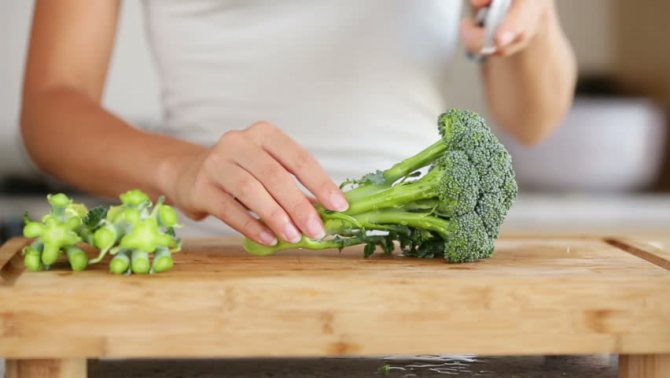
A nursing mother should gradually introduce broccoli into her diet, observing the baby’s reaction.
There is no need to include broccoli in your diet in the first six months if the baby’s immediate family suffers from intolerance to this product.
How to choose a product
Mom often faces the question of the quality of the product. Basically, you can buy asparagus cabbage in two versions: fresh or frozen. When choosing fresh broccoli, you need to pay attention to its appearance. Cabbage inflorescences should be rich green (sometimes a slight purple tint is possible), the stem should be strong and juicy. If the vegetable is limp and has begun to turn yellow, you should not take it - it is either stale or overripe.
When buying frozen broccoli, it is better to give preference to a familiar manufacturer. Ice in the package or sticky pieces of cabbage are an indicator of improper storage of the product and re-freezing. Broccoli from the freezer often contains more vitamins than the fresh version (subject to sales standards, of course). Because as a result of transportation and long-term storage, fresh vegetables lose many valuable substances.
Video: Live healthy! Broccoli
How to properly cook asparagus cabbage
To preserve the beneficial properties of cabbage, a woman needs to cook it properly. It is no secret that grinding the product and heat treatment does not have the best effect on some vitamins and minerals:
- Vitamin C does not tolerate high temperatures very well, as well as contact with air oxygen and metals;
- up to 30% of B vitamins are destroyed during the cooking process, some of them go into the decoction;
- despite the fact that fat-soluble vitamins A, D, E, K, macro- and microelements are resistant to heat, during prolonged cooking they also partially remain in the broth.
A nursing mother will get the maximum benefit from broccoli by consuming it raw. But in the first months it is better to blanch the cabbage, that is, briefly treat it with steam or boiling water.
To conserve vitamins and minerals, it is advisable for a woman to adhere to the following recommendations:
- There is no need to finely chop the broccoli. The larger the pieces, the more retained the beneficial properties of cabbage.
- It is necessary to lower the vegetable into already boiling water.
- Vitamins C and group B love an acidified environment, so when preparing dishes you can add a little vinegar or lemon juice.
- It is better to boil or stew broccoli in small volumes of water, of course, with the exception of soups.
- You need to cook food under the lid.
- Frozen vegetables do not require pre-thawing.
- Cabbage should be cooked for no more than 5–10 minutes.
It is advisable to eat the finished dish warm immediately. It is recommended to store food for no more than a day in a cool place. In this case, you need to cool the broccoli as quickly as possible and put it in the refrigerator.
Healthy recipes
Broccoli soufflé
- for dough: flour – 150 g and butter – 50 g;
- for soufflé: broccoli – 500 g, cream – 100 g, cheese – 50 g, eggs – 2 pcs., flour – 1 tbsp., salt and basil to taste.
Grind the flour with butter until a mass resembling bread crumbs is obtained. Add 4 tbsp. water and knead the dough. Place it in the refrigerator for 30-40 minutes. Prepare our soufflé: boil the broccoli for 15 minutes in salted water, then wipe. Dry the flour until creamy, cool, then dilute with cream and boil until thick. Mix the resulting sauce with broccoli, adding the yolks. Let's move on to working with the dough: roll out, cut out circles and place in greased molds (press firmly). Bake for 20 minutes at 200 degrees. Place the soufflé in the prepared tartlets, place broccoli on the edges, sprinkle with cheese and bake in the oven for a couple of minutes.
Soufflé is one of the safest ways to prepare food during breastfeeding. You can omit the dough from the recipe and prepare broccoli soufflé in ceramic molds
Cabbage cutlets
- fresh cabbage – 800 gr.;
- carrots – 5-6;
- eggs – 3;
- bulbs – 2;
- vegetable oil – 3 tbsp;
- pepper, salt, herbs to taste.
Wash the cabbage, cut into 4 parts and place in boiling salted water. Then we put it in a colander, squeeze it out and pass it through a meat grinder. After this, you need to cut and sauté the onion and grate the carrots. Mix all ingredients, add salt and pepper, eggs. Form cutlets and bake in the oven for 20 minutes.
Roasted Cauliflower
- cauliflower – 700 g;
- vegetable broth – 250 ml;
- grated cheese – 120 g.
Add cabbage inflorescences to the heated vegetable broth and cook over low heat for 12-15 minutes. After this, take it out and transfer it to a baking dish, pouring with a small amount of broth. Sprinkle with grated cheese and bake at 200 degrees for 15-20 minutes.
Recipes for nursing mothers
Using a steamer or roasting broccoli in the oven are the gentlest ways to cook cabbage. Various vegetable soups made with low-fat broth are also beneficial for a nursing mother. But a woman should avoid frying broccoli in a frying pan.
Steamed broccoli
- Wash the cabbage and cut into pieces.
- Place the inflorescences in a steamer for 10–15 minutes.
- You can check the softness with a knife.
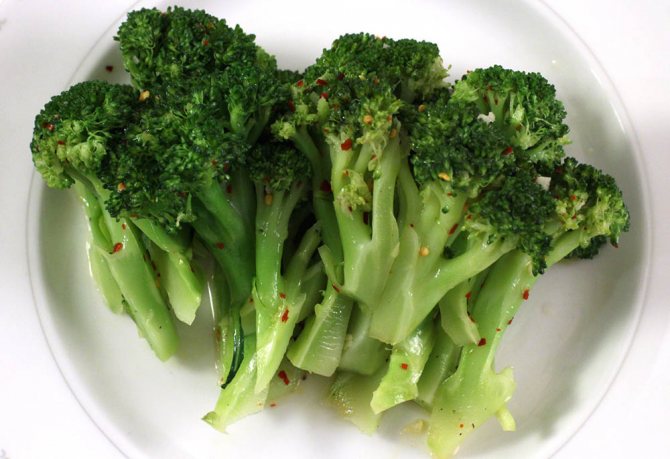
Broccoli from a steamer can also be consumed in the first month after childbirth.
Vegetable soup with broccoli and chicken breast
(soup can be prepared from frozen vegetables; there is no need to defrost them first)
Ingredients:
- chicken breast;
- carrot;
- broccoli;
- cauliflower;
- Brussels sprouts;
- salt, seasoning to taste;
- greens (dill, parsley).
Cooking method:
- Cook chicken breast broth. Cut the meat.
- Peel and wash the vegetables.
- Tear the cabbage into pieces, cut the carrots into cubes.
- Add carrots and Brussels sprouts to the broth and cook for about 10 minutes.
- Add cauliflower and broccoli.
- Cook until the vegetables are soft for another 5-10 minutes.
- Salt and season the soup.
- You can add fresh herbs.
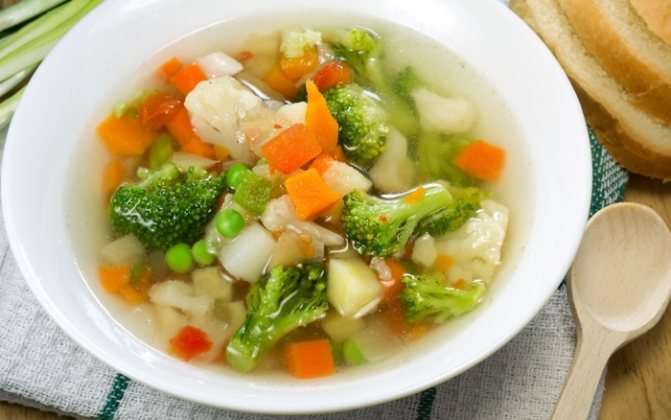
Vegetable soup with broccoli and chicken breast contains many useful substances
Broccoli casserole
Ingredients:
- broccoli 200 g;
- cream 100 ml;
- chicken egg 1–2 pcs.;
- hard cheese about 70 g;
- a little butter;
- flour 1 tbsp. spoon;
- salt and pepper to taste.
Cooking method:
- Wash and separate the cabbage into florets.
- Boil broccoli for 3 minutes. Drain the water.
- Grate the cheese.
- Mix eggs, spices, flour, add cream.
- Add half the cheese to the mixture.
- Preheat the oven to 180–200°C.
- Grease a baking dish with butter and place the broccoli in it.
- Pour the prepared mixture over the cabbage.
- Place the dish in the oven for 10–15 minutes.
- Next, sprinkle with the remaining cheese and place in the oven for about another 5-7 minutes until a crust forms.
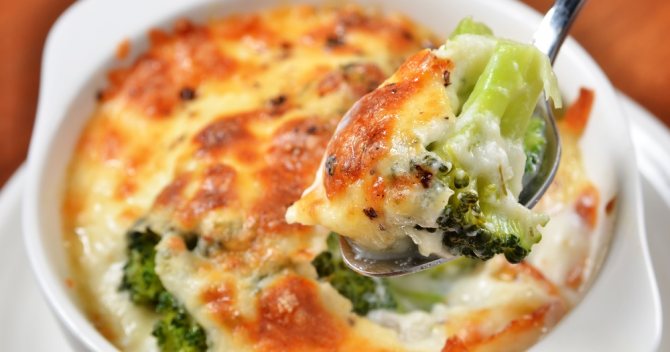
Broccoli casserole pleasantly diversifies the menu of a nursing mother
Broccoli soup with cream
Ingredients:
- broccoli 400 g;
- cream 100 ml;
- nutmeg 5 g;
- butter 1 tbsp. spoon;
- onion 1 pc.;
- salt and ground black pepper to taste.
Cooking method:
- Wash and peel the vegetables.
- Disassemble the cabbage into inflorescences and chop the onion.
- Simmer the onion in a frying pan in butter until soft and translucent.
- Boil 250 ml of water, add onions and broccoli.
- Add salt and spices to the soup.
- Cook for about 10 minutes until the cabbage is soft.
- Next, remove from heat and grind the pieces using a blender.
- Add a little nutmeg and pour in the cream.
- Mix everything with a blender.
- The finished soup can be served with croutons and grated cheese.
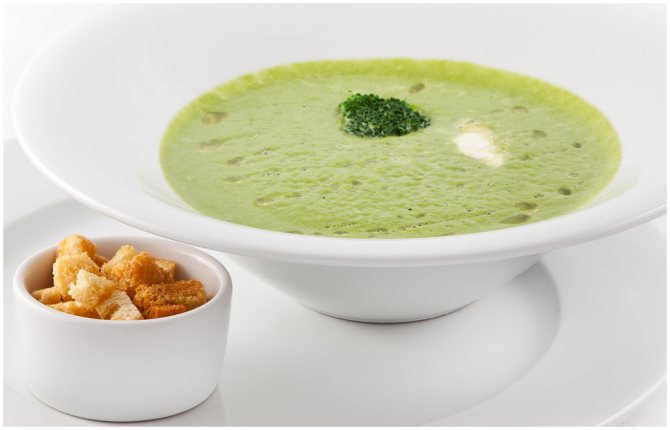
Creamy broccoli soup - a healthy lunch for mom and baby
Cooking tips
Boiled broccoli is an excellent side dish for meat and fish.
Boiled broccoli, crushed to a puree, is easiest to digest in the stomach. In this form, it is advisable to start introducing the vegetable into the diet. First, the cabbage is divided into inflorescences and washed under running water. Then the vegetable is boiled in water or steamed until cooked, or not completely, then drained and added to other dishes or baked in the oven, for example. During further cooking, the cabbage will be fully cooked. It’s easy to understand that broccoli is ready - the stem becomes soft, a knife passes through it easily, but the cabbage does not fall apart and retains its shape. Usually 6-7 minutes of cooking is enough for this. If the product is used as a side dish, then after boiling it is recommended to immerse it in ice water for 10–20 seconds - this will ensure that the vegetable retains its shape and moderate hardness.
How to choose
The healthiest broccoli for a nursing mother - grown with your own hands
During breastfeeding, the quality of the products consumed requires special attention. To select and buy fresh and healthy broccoli, follow these tips:
- the inflorescences are elastic to the touch, bright green in color;
- there should be no yellow or dark spots on the surface;
- the stems should be thin, otherwise the broccoli will become overripe and too fibrous;
- the most preferable vegetable is grown with your own hands or in your native area;
- For a frozen product, the inflorescences should be separate and without a thick layer of frost, and the external characteristics should be the same as those of fresh broccoli.
Store broccoli in the refrigerator in a paper bag in the vegetable compartment. Thawed product cannot be re-frozen.
Recipes for nursing mothers
Broccoli can be eaten boiled or as part of complex dishes.
Broccoli can be eaten as an independent dish, combined with fats (vegetable oil, sour cream) for better absorption of vitamins. It is acceptable to add cabbage to complex dishes - soups, casseroles, stews. Broccoli goes well with foods rich in animal proteins - meat, fish, eggs, dairy products.
Pasta with broccoli
You can add boiled chicken meat, cut into pieces, to the pasta
Ingredients:
- broccoli 300 g;
- hard cheese 100 g;
- pasta 300 g;
- salt and spices to taste.
Cooking process:
- Divide the broccoli into florets and rinse under running water.
- Bring water in a saucepan to a boil, add broccoli and salt.
- Cook until done, about 5–10 minutes.
- Boil the pasta in salted water until tender.
- Grate the cheese on a coarse grater.
- Place pasta in a baking dish, add broccoli, stir.
- Sprinkle with cheese.
- Bake at 180 degrees for 10 minutes.
Warm vegetable salad
The salad may include your favorite vegetables that do not provoke allergies or colic in your baby.
Ingredients:
- broccoli 300 g;
- carrots 1 pc.;
- potatoes 2 pcs.;
- salt to taste;
- dill and parsley;
- sour cream for dressing.
Cooking process:
- Wash the broccoli, divide into florets and boil in salted water.
- Wash the vegetables, boil until tender in different dishes.
- Peel the carrots and potatoes, cut into cubes.
- Cut the broccoli as desired.
- Finely chop the greens with a knife.
- Mix all ingredients, add salt and add sour cream.
Cream soup with broccoli
The soup can be served with sour cream and croutons
Ingredients:
- broccoli 500 g;
- chicken broth 1 l;
- onion 1 head;
- garlic 2 cloves;
- hard cheese 30 g;
- salt to taste.
Cooking process:
- Peel the onion and garlic and cut into cubes.
- Bring chicken broth to a boil, add broccoli florets.
- Cook for about 5 minutes, then add onion and garlic, salt.
- Cook for about 5 more minutes.
- Grate the cheese.
- Turn off the stove and let the soup cool slightly.
- Add cheese, beat all ingredients with a blender.
